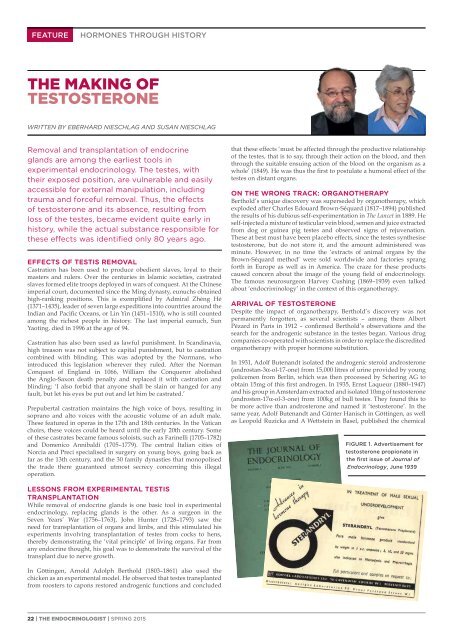1CIShci
1CIShci
1CIShci
You also want an ePaper? Increase the reach of your titles
YUMPU automatically turns print PDFs into web optimized ePapers that Google loves.
FEATURE<br />
HORMONES THROUGH HISTORY<br />
THE MAKING OF<br />
TESTOSTERONE<br />
WRITTEN BY EBERHARD NIESCHLAG AND SUSAN NIESCHLAG<br />
Removal and transplantation of endocrine<br />
glands are among the earliest tools in<br />
experimental endocrinology. The testes, with<br />
their exposed position, are vulnerable and easily<br />
accessible for external manipulation, including<br />
trauma and forceful removal. Thus, the effects<br />
of testosterone and its absence, resulting from<br />
loss of the testes, became evident quite early in<br />
history, while the actual substance responsible for<br />
these effects was identified only 80 years ago.<br />
EFFECTS OF TESTIS REMOVAL<br />
Castration has been used to produce obedient slaves, loyal to their<br />
masters and rulers. Over the centuries in Islamic societies, castrated<br />
slaves formed elite troops deployed in wars of conquest. At the Chinese<br />
imperial court, documented since the Ming dynasty, eunuchs obtained<br />
high-ranking positions. This is exemplified by Admiral Zhèng Hé<br />
(1371–1435), leader of seven large expeditions into countries around the<br />
Indian and Pacific Oceans, or Lin Yin (1451–1510), who is still counted<br />
among the richest people in history. The last imperial eunuch, Sun<br />
Yaoting, died in 1996 at the age of 94.<br />
Castration has also been used as lawful punishment. In Scandinavia,<br />
high treason was not subject to capital punishment, but to castration<br />
combined with blinding. This was adopted by the Normans, who<br />
introduced this legislation wherever they ruled. After the Norman<br />
Conquest of England in 1066, William the Conqueror abolished<br />
the Anglo-Saxon death penalty and replaced it with castration and<br />
blinding: ‘I also forbid that anyone shall be slain or hanged for any<br />
fault, but let his eyes be put out and let him be castrated.’<br />
Prepubertal castration maintains the high voice of boys, resulting in<br />
soprano and alto voices with the acoustic volume of an adult male.<br />
These featured in operas in the 17th and 18th centuries. In the Vatican<br />
choirs, these voices could be heard until the early 20th century. Some<br />
of these castrates became famous soloists, such as Farinelli (1705–1782)<br />
and Domenico Annibaldi (1705–1779). The central Italian cities of<br />
Norcia and Preci specialised in surgery on young boys, going back as<br />
far as the 13th century, and the 30 family dynasties that monopolised<br />
the trade there guaranteed utmost secrecy concerning this illegal<br />
operation.<br />
that these effects ‘must be affected through the productive relationship<br />
of the testes, that is to say, through their action on the blood, and then<br />
through the suitable ensuing action of the blood on the organism as a<br />
whole’ (1849). He was thus the first to postulate a humoral effect of the<br />
testes on distant organs.<br />
ON THE WRONG TRACK: ORGANOTHERAPY<br />
Berthold’s unique discovery was superseded by organotherapy, which<br />
exploded after Charles Edouard Brown-Séquard (1817–1894) published<br />
the results of his dubious self-experimentation in The Lancet in 1889. He<br />
self-injected a mixture of testicular vein blood, semen and juice extracted<br />
from dog or guinea pig testes and observed signs of rejuvenation.<br />
These at best must have been placebo effects, since the testes synthesise<br />
testosterone, but do not store it, and the amount administered was<br />
minute. However, in no time the ‘extracts of animal organs by the<br />
Brown-Séquard method’ were sold worldwide and factories sprang<br />
forth in Europe as well as in America. The craze for these products<br />
caused concern about the image of the young field of endocrinology.<br />
The famous neurosurgeon Harvey Cushing (1869–1939) even talked<br />
about ‘endocriminology’ in the context of this organotherapy.<br />
ARRIVAL OF TESTOSTERONE<br />
Despite the impact of organotherapy, Berthold’s discovery was not<br />
permanently forgotten, as several scientists – among them Albert<br />
Pézard in Paris in 1912 – confirmed Berthold’s observations and the<br />
search for the androgenic substance in the testes began. Various drug<br />
companies co-operated with scientists in order to replace the discredited<br />
organotherapy with proper hormone substitution.<br />
In 1931, Adolf Butenandt isolated the androgenic steroid androsterone<br />
(androstan-3α-ol-17-one) from 15,000 litres of urine provided by young<br />
policemen from Berlin, which was then processed by Schering AG to<br />
obtain 15mg of this first androgen. In 1935, Ernst Laqueur (1880–1947)<br />
and his group in Amsterdam extracted and isolated 10mg of testosterone<br />
(androsten-17α-ol-3-one) from 100kg of bull testes. They found this to<br />
be more active than androsterone and named it ‘testosterone’. In the<br />
same year, Adolf Butenandt and Günter Hanisch in Göttingen, as well<br />
as Leopold Ruzicka and A Wettstein in Basel, published the chemical<br />
FIGURE 1. Advertisement for<br />
testosterone propionate in<br />
the first issue of Journal of<br />
Endocrinology, June 1939<br />
LESSONS FROM EXPERIMENTAL TESTIS<br />
TRANSPLANTATION<br />
While removal of endocrine glands is one basic tool in experimental<br />
endocrinology, replacing glands is the other. As a surgeon in the<br />
Seven Years’ War (1756–1763), John Hunter (1728–1793) saw the<br />
need for transplantation of organs and limbs, and this stimulated his<br />
experiments involving transplantation of testes from cocks to hens,<br />
thereby demonstrating the ‘vital principle’ of living organs. Far from<br />
any endocrine thought, his goal was to demonstrate the survival of the<br />
transplant due to nerve growth.<br />
In Göttingen, Arnold Adolph Berthold (1803–1861) also used the<br />
chicken as an experimental model. He observed that testes transplanted<br />
from roosters to capons restored androgenic functions and concluded<br />
22 | THE ENDOCRINOLOGIST | SPRING 2015


